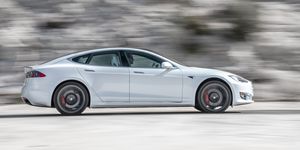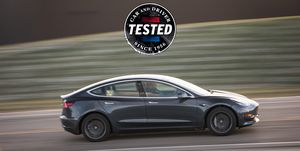- Tesla’s 2020.12.6 software release moves the needle toward the promised (and paid for) full self-driving capability; we tried it out in our Model 3.
- However, in addition to stopping for stop signs and red lights, it also stops for green lights, severely diminishing its usefulness.
- This is one of many, many more improvements to come to achieve the “robotaxi” capability that Elon Musk has promised will come to be in 2020.
“You take it on faith, you take it to the heart . . . the waiting is the hardest part,” goes Tom Petty’s chorus in “The Waiting,” which, although released in 1981, very accurately describes today’s Tesla owners and the Full Self Driving capability for which they’ve already paid as much as $7000. The latest software, 2020.12.6, now includes the ability to automatically recognize and slow for stop signs and traffic lights. Tesla calls it Traffic Light and Stop Sign Control, and it’s another of its “beta” features. That’s a significant step toward bolstering the capability of its Autopilot suite of driver-assist features, and it makes Tesla the only automaker with adaptive cruise control that now does so.
This builds on the release from about three months ago, which added new visualization features that show up in the gauge cluster, or, in the Model 3’s case, on the left side of its large center screen. There it depicts the traffic lights, signs, construction cones, and pedestrians that its eight cameras, 12 ultrasonic sensors, and one forward radar unit are seeing. But, until now, it didn’t react to them.
This new feature works when using Autopilot cruise control, either with or without the active steering turned on. However, a new quirk is that, with the steering functionality on, the maximum set speed for the cruise on roads other than highways is now the speed limit, down from the 5 mph over that was previously allowed.
As an intersection is approaching, a pop-up message on the screen informs the driver that the car will be “stopping for traffic control” in a specified number of feet. The warnings start as soon as 600 feet if it can see far enough ahead, and then it counts down to zero when it starts slowing. It also puts a red line in the visualization area, which is where the car is planning on coming to a complete stop. As with many adaptive-cruise-control systems, once stopped, a tap of the cruise-control stalk (which, in the Model 3, is also the shift lever) or gas pedal is required to accelerate again. Although the system sometimes gives a slightly too aggressive jab at the brakes toward the end of a stop, at first it all seemed to be working as intended.
But then we encountered a green light, and it also stopped for that. This quickly becomes tedious when going through a downtown area with a series of green traffic lights every block or two and having to be constantly tipping into the throttle to override the system’s misguided desire for deceleration. We started to wonder whether or not this is even progress, as in these types of circumstances this new feature is increasing, rather than decreasing, the number of driver interventions required.
It did at least reliably identify every stop sign, red/yellow/green light, or left-turn signal and broadcast its intent on stopping for all of them. The only slight glitch we encountered was when the car erroneously reacted to a stop sign that was actually on an adjoining road. The oblique angle between the two roads made the sign too visible, apparently, but almost as quickly as it stabbed the brakes, the system realized its error and backed off.
As always, Tesla will be using the real data from its guinea-pig owners to iterate toward increased capability. We’ll be waiting.
Source: Motor - aranddriver.com






